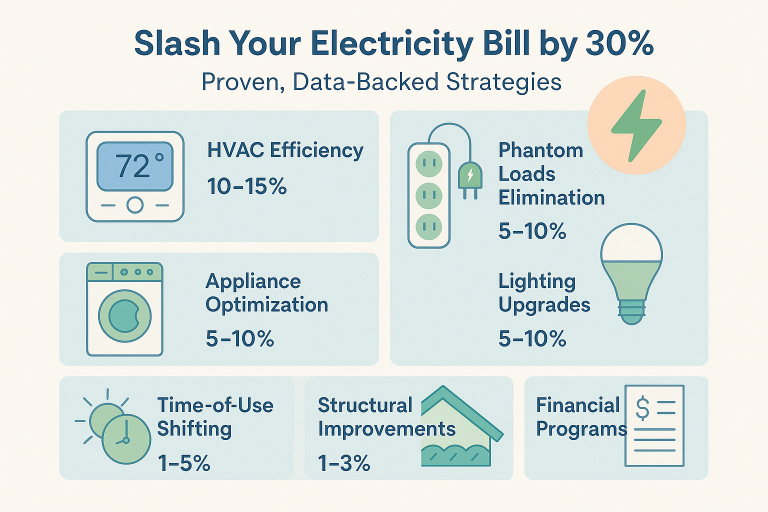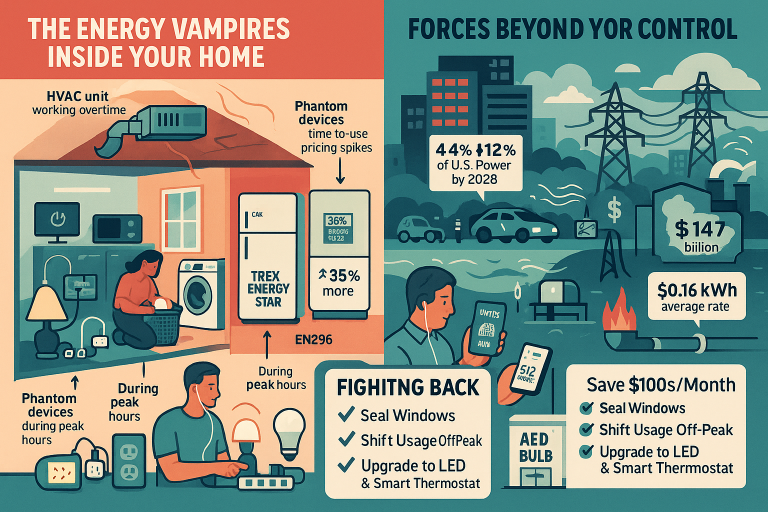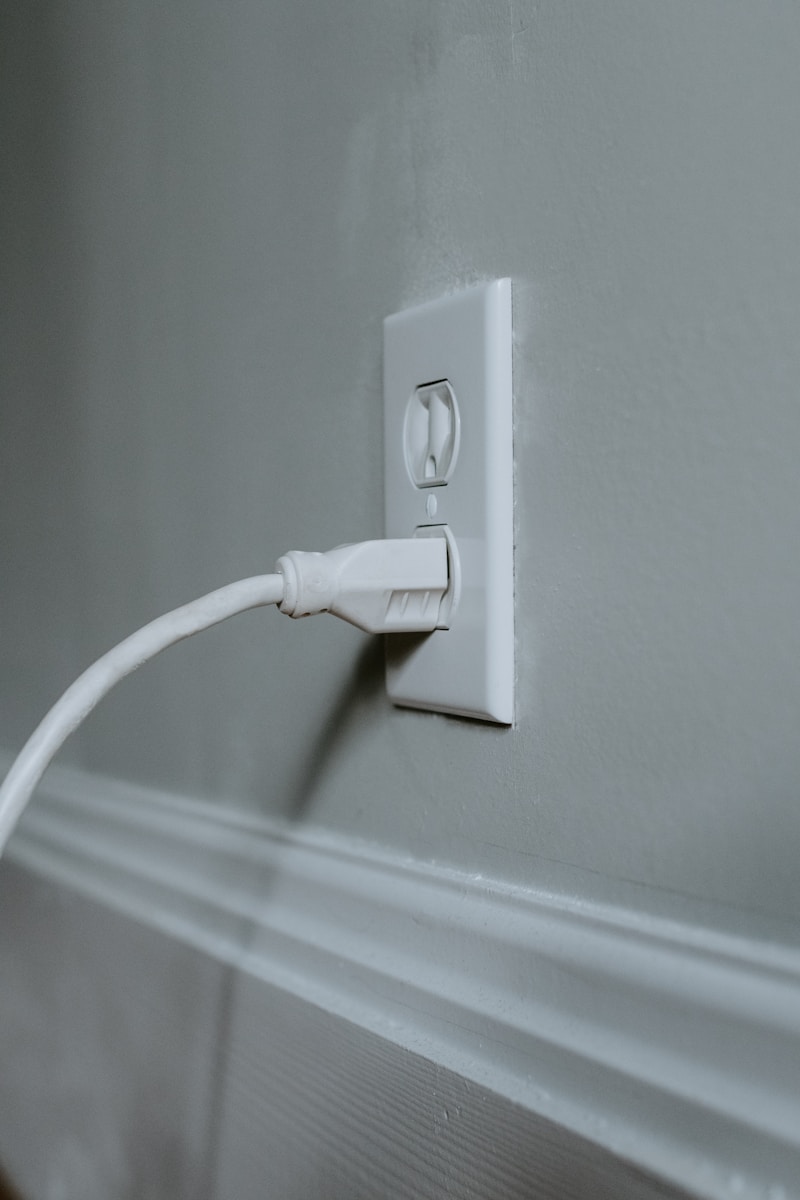Ohio’s Average Electric Bill: Costs, Trends, and Savings Strategies
Ohio’s electricity landscape sits at the crossroads of affordability and volatility, with residents navigating complex rate structures, regional variations, and impending price increases. This in-depth analysis examines every facet of Ohio’s electric bills to empower consumers with actionable knowledge for managing energy costs effectively.
Key Ohio Electricity Statistics at a Glance
- Current Average Monthly Bill: $130-$186
- Average Electricity Rate: 16.34¢/kWh (slightly below national average)
- Typical Monthly Consumption: 811-1,190 kWh
- National Bill Ranking: 32nd highest among states
- Projected Increase (June 2025): 10-15% due to capacity costs
| Metric | Ohio | National Average | Difference |
|---|---|---|---|
| Rate per kWh | 16.34¢ | 17.45¢ | 6.4% lower |
| Monthly Consumption | 811-1,190 kWh | 855 kWh | 0-39% higher |
| Monthly Bill | $132-$186 | $154 | 0-21% higher |
| Annual Cost | $1,584-$2,232 | $1,848 | Varies |
Breaking Down the Ohio Electricity Bill
- Rate Components:
- Generation Charges (40-60%): Cost to produce electricity, varying between utilities and competitive suppliers. As of July 2025, AEP Ohio’s “Price to Compare” is 10.52¢/kWh, while The Illuminating Company charges 9.39¢/kWh.
- Transmission & Distribution (30-40%): Regulated charges for delivering electricity through local grids, including infrastructure maintenance costs.
- Capacity Charges (10-20%): Unique PJM Interconnection fees ensuring future grid reliability, which saw an 833% increase in June 2025 auctions.
- Regulatory Fees & Taxes: State and local surcharges including sales tax and energy efficiency program costs.
- Consumption Patterns:
- Seasonal Variability: Average usage spikes 30-50% during summer (AC) and winter (heating) months. July usage often exceeds 1,200 kWh for central Ohio homes.
- Home Size Impact: A 1,500 sq ft home averages $140 monthly, while 3,000 sq ft homes often exceed $200.
- Urban/Rural Divide: Columbus residents pay approximately 18% more than rural areas like Loveland due to higher distribution costs and demand charges.
Factors Influencing Your Ohio Electric Bill
- Geographic Location: Northern Ohio (Cleveland) faces higher rates (19.95¢/kWh) than southern regions (Cincinnati – 16.10¢/kWh) due to different utility territories and infrastructure costs.
- Home Characteristics:
- Age of Home: Pre-1980 constructions lack modern insulation, increasing HVAC costs by 25-40%
- Appliance Efficiency: Electric water heaters add $30-$60 monthly; HVAC systems constitute 40-50% of total usage.
- Heating Fuel Source: All-electric homes have 35% higher winter bills than gas-heated homes
- Regulatory Environment: Ohio’s hybrid deregulated market allows consumers to choose suppliers but has experienced volatility, with commercial customers facing 29% increases from capacity costs versus 10-15% for residents.
| Season | Avg. Usage | Key Drivers | Cost Management Tips |
|---|---|---|---|
| Summer (Jun-Aug) | 1,100-1,400 kWh | Central AC, pool pumps | Use programmable thermostats; avoid 5-7 PM peak |
| Winter (Dec-Feb) | 900-1,300 kWh | Electric heating, lighting | Seal drafts; use zone heating; maintain furnace |
| Shoulder Seasons | 600-900 kWh | Minimal HVAC needs | Open windows; use natural ventilation |
Regional Context: How Ohio Compares
- Neighboring States:
- Michigan: Higher rates (19.95¢/kWh) but lower usage ($121 avg bill)
- Pennsylvania: 18.98¢/kWh with $150 average monthly bill
- Indiana: 17.01¢/kWh with $149 average bill
- National Position: Ohio ranks 31st for electricity rates (16.34¢/kWh vs. national 17.45¢) but 32nd for overall bills due to above-average consumption. This positions Ohio in the middle tier of affordability—significantly cheaper than New England (Connecticut: 32.28¢/kWh) but more expensive than energy-rich states (North Dakota: 11.69¢/kWh).
Critical 2025 Rate Changes and Impacts
A seismic shift is occurring in Ohio’s energy market with the PJM capacity auction resulting in an 833% increase in capacity costs effective June 2025. This will manifest in two waves:
- Immediate Impact (June 2025):
- Residential bills increase 10-15% (≈2¢/kWh)
- Example: $150 bill becomes $165-$173 monthly
- Commercial customers face up to 29% increases
- Underlying Mechanics:
- Capacity costs now represent 25-40% of generation charges
- Your specific increase depends on “Peak Load Contribution” (PLC) tags determined during the 5 highest usage hours the previous summer between 5-7 PM
| Supplier | Plan Name | Term | Rate | Utility Areas |
|---|---|---|---|---|
| Public Power | 12 Month Fixed w/ Monthly Fee | 12 mo | 8.09¢/kWh | AEP, Illuminating |
| APG&E | True Classic 6 w/ Fee | 6 mo | 8.60¢/kWh | AEP Ohio |
| Energy Harbor | Safe Harbor Value 12 | 12 mo | 8.89¢/kWh | Illuminating Co |
Proven Strategies to Reduce Your Ohio Electric Bill
- Supplier Selection:
- Fixed-rate plans from third-party suppliers currently offer rates as low as 8.09¢/kWh, significantly below utility default rates (9.39-10.52¢/kWh). These lock in protection against future increases.
- Strategic Usage Reduction:
- Peak Shaving: Reduce usage between 5-7 PM on hot summer days when PLC tags are set. This can lower future capacity charges by 15-30%.
- Efficiency Upgrades: ENERGY STAR appliances reduce consumption by 20-30%; LED lighting cuts lighting costs by 75%.
- Solar Investments:
- Ohio’s 11.1 kW system (average cost: $29,000 before incentives) delivers 12.4-year payback with $2,200 first-year savings. Federal tax credits cover 30% of installation costs.
- Behavioral Adjustments:
- Set thermostats to 78°F in summer and 68°F in winter (saves 10% annually)
- Seal air leaks with weatherstripping (reduces HVAC costs 15-20%)
- Maintain HVAC systems with seasonal tune-ups
Future Outlook and Consumer Action Plan
Ohio’s energy market faces continued volatility through 2026, though new auction rules may moderate future increases. Consumers should:
- Audit Current Costs: Calculate your exact rate (bill amount ÷ kWh used) and compare to Ohio’s average 16.34¢/kWh.
- Lock In Rates: Secure 12-24 month fixed-rate contracts before June 2025 increases fully impact bills.
- Monitor PLC Tags: Request your Peak Load Contribution tag from your utility and implement targeted peak reduction.
- Evaluate Solar: With 20-25% annual electricity inflation, solar payback periods are shrinking rapidly in Ohio.
While Ohio’s electricity costs remain moderately positioned nationally, the convergence of capacity cost spikes and seasonal usage patterns creates both challenges and opportunities for proactive consumers. By understanding bill components, implementing strategic reductions, and leveraging Ohio’s competitive supplier market, residents can effectively navigate the evolving energy landscape and maintain control over their household energy budgets.






